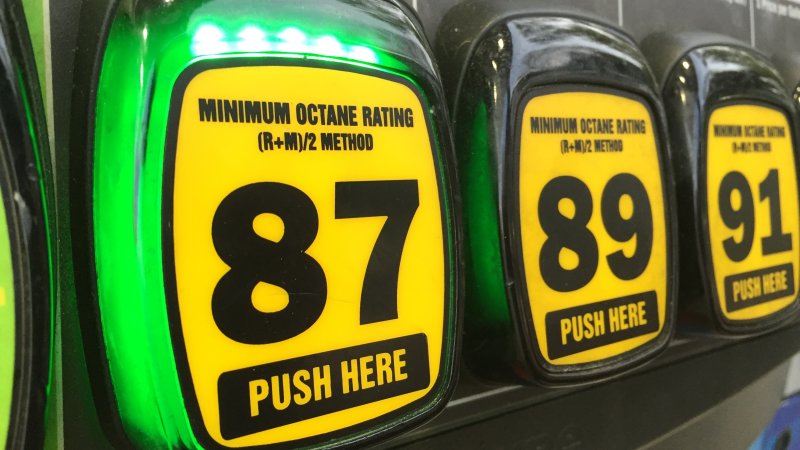Freeze Fuel-Economy Goals to Save Lives? A Closer Look at Feds’ Claim
ANGLO AMERICA, ENERGY, ENVIRONMENT, 6 Aug 2018
Greg Rasa | Autoblog – TRANSCEND Media Service
Trump Administration Says 12,700 Deaths Will Be Prevented
2 Aug 2018 – A key point in the Trump administration’s argument for rolling back Obama-era fuel economy standards is that those standards will increase the number of traffic fatalities. Specifically, the claim is that 12,700 more people will die if the standards aren’t frozen at 2020 levels through 2026. The lifesaving argument is so central, the proposal has even been dubbed the SAFE Vehicles Rule (“Safer Affordable Fuel-Efficient”).
“It is now recognized that, as the stringency of standards increases, so does the likelihood that higher stringency will increase on-road fatalities,” wrote Trump administration officials in the draft of the proposal. “As it turns out, there is no such thing as a free lunch.”
Yet the Obama administration’s analysis of the same rule back in 2012 found that improving fuel-economy standards would actually reduce auto-related deaths by about 100. No surprise that two administrations with two different agendas and world views would interpret the same data two different ways.
Freezing the incremental increase in fuel-economy standards, the government’s theory goes, will save lives in a number of ways:
- People will drive fewer miles if they’re getting fewer miles per gallon. (Yet they’ll burn a half-million more barrels of oil per day, the report says.) Plus, the fuel will cost more.
- Vehicles won’t have to be made lighter. Heavier is safer.
- Relieved of the costs of meeting the Obama-era standards, automakers will sell cheaper vehicles, and the public will more quickly transition into newer cars with the latest safety technologies.
“This rule promises to save lives,” said Heidi King, acting administrator for the National Highway Traffic Safety Administration, who was a key author of the proposal. “It could save up to a thousand lives annually by reducing these barriers that prevent consumers from getting into newer, safer cars.”
The first point has merit. The overall trend line for vehicular deaths in the U.S. has been downward since the 1980s, but as the nation emerged from the recession of 2007-08 and employment rates climbed, so did vehicular miles traveled — and so have fatalities, jumping to over 37,000 in 2016, the most recent year for which there is data. There’s a correlation between vehicle miles and more deaths, for sure. But there are also confounding variables for the increased deaths, such as increased driver (and pedestrian) distraction from use of smart phones.
The second point is perhaps half true. The proposed rule estimates that decreasing by 100 pounds the weight of a lightweight car (defined as less than 3,200 pounds) increases the risk of death by 1.5 percent. Stands to reason, right? And of course the situation is worse when a light vehicle collides with a heavy vehicle. But here’s where the proposal is half-wrong, and even provides the documentation that it’s wrong: Reducing the mass of a heavier vehicle such as a truck or SUV “has a great benefit” to the occupants of the lighter vehicle in the crash. And the Obama-era CAFE standards have been the driving force behind automakers’ many steps to reduce the weight of hot-selling pickups and crossovers.
Plus, a far bigger factor in safety is engineering. Consider the amazing crash protection built in to lightweight race cars. David Zuby, chief research officer at the Insurance Institute for Highway Safety, told The Associated Press other factors will likely more positively affect traffic deaths, such as automatic emergency braking becoming standard. “They’re making assumptions about stuff that may or may not be the same,” he said.
“Allow me to be skeptical,” said Giorgio Rizzoni, an engineering professor who heads the Center for Automotive Research at Ohio State University. “To say that safety is a direct result of somehow freezing the fuel economy mandate for a few years, I think that’s a stretch.”
Experts say lighter vehicles with metals such as aluminum, magnesium, titanium and high-strength steel alloys perform better in crash tests. Alan Taub, professor of materials science and engineering at the University of Michigan, told the AP he would choose a 2017 Malibu over a heavier one from 20 years ago. It’s engineered better in all ways. “You want to be in the newer vehicle,” he said.
Which is a nice segue into the government’s third point: Freezing fuel economy standards will get people into newer cars faster. But does it seem plausible that automakers would lower MSRPs by significant amounts if no longer faced with that 2026 deadline? The average new-vehicle transaction cost hit $34,700 in 2017, up from about $30 grand in 2012 when the Obama-era standards were implemented. But once again, many other factors helped drive up the increase, including post-recession pent-up demand for new cars, the new safety technologies the SAFE plan is hoping you’ll ditch your old car to buy, and especially the strong consumer trend away from traditional cars and into higher-priced, even luxury, pickup trucks and SUVs.
We’ll hear many voices in the weeks to come saying that the Obama goals, rather than serving as a boot on the neck of automakers, were more of a boot to their backsides, spurring innovation that in fact could make cars not just more fuel-efficient and safer, but cheaper as well. Prof. John DeCicco of the University of Michigan Energy Institute, who has had his quibbles about EVs and hybrids, had this to say this morning about the SAFE Vehicles Rule:
The administration’s effort to roll back these standards is a denial of basic science and a denial of American automakers’ engineering capabilities and ingenuity.
Transportation is the nation’s largest source of the excess CO2 emissions that cause global warming. Both science and economics show that motor vehicle efficiency and greenhouse gas standards are crucial and effective ways to deal with this problem.
There has been enormous progress in automotive engineering. This progress provides automakers with many low-cost ways to achieve steady gains in efficiency and meet the strong but fair and flexible standards developed six years ago.
The past decade saw average new car and light truck fuel economy rise by 23% even as sales reached new highs and vehicles improved in performance and in many other ways. This progress is a tribute to engineering ingenuity and it refutes any claims that stronger standards put sales, jobs and profits at risk.
Michigan’s automakers have the technology and intellectual capital needed to meet ever-tighter MPG and GHG emission targets. The standards are designed with flexibility in mind, and have already adjusted to the shift back to SUVs and other light trucks.
California and other states will be well justified in an effort to preserve their rights to keep strong standards in place and ensure environmental progress.
It’s important to note that not even the automakers wanted the goals frozen for six years. They had agreed to those goals in 2012 under Obama, but when Trump entered office, they asked for a softening — but not a freeze. Even today, as the SAFE plan was announced, two automaker trade groups released a statement saying “automakers support continued improvements in fuel economy and flexibilities that incentivize advanced technologies while balancing priorities like affordability, safety, jobs, and the environment.”
Meanwhile, expect environmentalists to oppose the plan by every means possible — one of which will be to say the administration’s view that cleaner cars kill more people is faulty.
“The administration is using a parade of horrors to justify an extreme rollback,” said Daniel Becker, director of the Safe Climate Campaign. “They lead to the conclusion that safety will be impaired. This will lead to more polluting vehicles, cost consumers more, and it won’t save any lives.”
The enviros point out that more people will die from asthma and other respiratory ailments brought on by (among other factors) vehicle emissions and increased pollen that may be associated with climate change. About 3,600 Americans die each year from asthma. Meanwhile, the administration’s calculation of 12,700 lives saved by the standards rollback is based on the lifetimes of cars sold through model year 2029 — in other words, that’s a projection for lives saved over the next couple of decades. So even though the annual death rate from asthma is thankfully low given how prevalent the condition is, the asthma-kills-more people argument might carry some weight.
Best guess on all of this: California, the other states that follow its lead, and the automakers are going to work something out, and automakers — particularly the foreign brands — will continue on the electrification path in which they are heavily investing. And ultimately the feds will go along, as acting EPA Administrator Andrew Wheeler hinted, and the SAFE Vehicles Rule will be ash-canned. We’ll follow the process.
______________________________________________
 Greg Rasa – Hi, I’m Autoblog’s managing editor. I was a kid in the muscle car era and worked my way through college as a lot attendant at a Chevrolet dealership before spending nearly 30 years as a newspaper editor. My first car was a Leuchtorange 1973 Volkswagen Type 3 fastback, and a current car is a Grabber Orange Mustang GT convertible. I like orange.
Greg Rasa – Hi, I’m Autoblog’s managing editor. I was a kid in the muscle car era and worked my way through college as a lot attendant at a Chevrolet dealership before spending nearly 30 years as a newspaper editor. My first car was a Leuchtorange 1973 Volkswagen Type 3 fastback, and a current car is a Grabber Orange Mustang GT convertible. I like orange.
DISCLAIMER: The statements, views and opinions expressed in pieces republished here are solely those of the authors and do not necessarily represent those of TMS. In accordance with title 17 U.S.C. section 107, this material is distributed without profit to those who have expressed a prior interest in receiving the included information for research and educational purposes. TMS has no affiliation whatsoever with the originator of this article nor is TMS endorsed or sponsored by the originator. “GO TO ORIGINAL” links are provided as a convenience to our readers and allow for verification of authenticity. However, as originating pages are often updated by their originating host sites, the versions posted may not match the versions our readers view when clicking the “GO TO ORIGINAL” links. This site contains copyrighted material the use of which has not always been specifically authorized by the copyright owner. We are making such material available in our efforts to advance understanding of environmental, political, human rights, economic, democracy, scientific, and social justice issues, etc. We believe this constitutes a ‘fair use’ of any such copyrighted material as provided for in section 107 of the US Copyright Law. In accordance with Title 17 U.S.C. Section 107, the material on this site is distributed without profit to those who have expressed a prior interest in receiving the included information for research and educational purposes. For more information go to: http://www.law.cornell.edu/uscode/17/107.shtml. If you wish to use copyrighted material from this site for purposes of your own that go beyond ‘fair use’, you must obtain permission from the copyright owner.
Read more
Click here to go to the current weekly digest or pick another article:
ANGLO AMERICA:
- Preparing to 'move on', US says Ukraine is 'not our war'
- Close Military Bases, Not Embassies
- "They're Kissing My Ass": Trump Says Tariffs Are Going Great, Promises Duty on Pharmaceuticals
ENERGY:
- China Opens World’s Largest Offshore Solar Power Facility
- Nuclear Industry Takes Control of NASA
- The Nuclear Energy Dilemma: Climate Savior or Existential Threat?
ENVIRONMENT:
